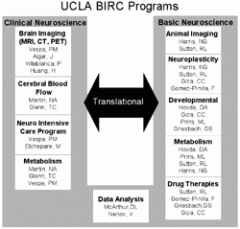BIRC Projects

We have spent several years describing the acute state of cerebral hyperglycolisis following traumatic brain injury.
The most impressive finding is that after this acute period the brain enters a state of metabolic depression. Of the many mechanisms behind this metabolic depression (disconnection, cell death, reduction in energy need, etc) for tissue which is intact and appearing to be responding (behavioral recovery) this may simply be due to a lack of fuel.
We now seek to identify the metabolic destination of cerebral glucose taken up after traumatic brain injury, thereby discovering alternative metabolic pathways receptive to interventions (metabolic therapy) to enhance cellular and functional recovery, which in turn may lead to fundamental changes in the future of TBI patient management.
One of the unique strengths of the UCLA BIRC program is the translational nature of the research. The BIRC has been able to take our new findings from our basic science research and confirm the observations clinically and then take new clinical problems and test solutions in the basic science laboratories. BIRC consists of both a clinical and basic science efforts which are shown in the figure.
Download and print BIRC Programs (PDF) >
An important Brain Injury Research Center initiative is to educate children, teenagers, and adults about basic neuroscience, share facts about traumatic brain injury and instill habits to protect the brain from injury.